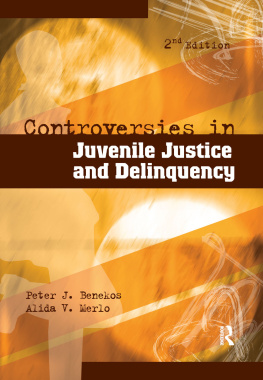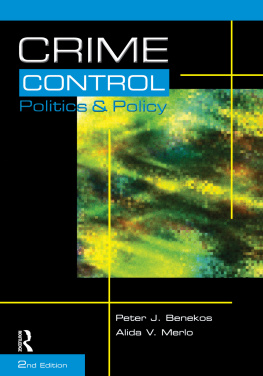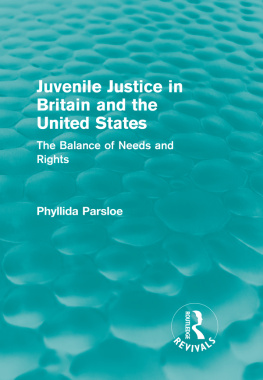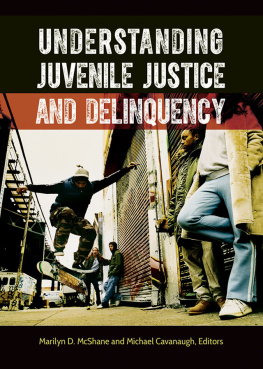2nd Edition
Controversies in
Juvenile Justice and Delinquency
Peter J. Benekos, Ph.D.
Mercyhurst College
Alida V. Merlo, Ph.D.
Indiana University of Pennsylvania
Controversies in Juvenile Justice and Delinquency, Second Edition
First published 2009 by Anderson Publishing
Published 2015 by Routledge
2 Park Square, Milton Park, Abingdon, Oxon OX14 4RN
and by Routledge
711 Third Avenue, New York, NY 10017, USA
Routledge is an imprint of the Taylor & Francis Group, an informa business
Copyright 2004, 2009
Taylor & Francis. All rights reserved.
No part of this book may be reprinted or reproduced or utilised in any form or by any electronic, mechanical, or other means, now known or hereafter invented, including photocopying and recording, or in any information storage or retrieval system, without permission in writing from the publishers.
Notices
No responsibility is assumed by the publisher for any injury and/or damage to persons or property as a matter of products liability, negligence or otherwise, or from any use of operation of any methods, products, instructions or ideas contained in the material herein.
Practitioners and researchers must always rely on their own experience and knowledge in evaluating and using any information, methods, compounds, or experiments described herein. In using such information or methods they should be mindful of their own safety and the safety of others, including parties for whom they have a professional responsibility.
Product or corporate names may be trademarks or registered trademarks, and are used only for identification and explanation without intent to infringe.
Controversies in Juvenile Justice and Delinquency/Peter J. Benekos and Alida V Merlo
p. cm.
Includes bibliographical references and index.
ISBN-13: 978-1-59345-5705 (pbk)
Cover design by Tin Box Studio, Inc./Cincinnati, OH
EDITOR Janice Eccleston
ACQUISITIONS EDITOR Michael C. Braswell
To our parents, John and Lillian Benekos, and Nicholas and Clara Merlo.
This project could not have happened without the contributions of our authors. We are very fortunate to have had the opportunity to work with such distinguished colleagues. We appreciate their scholarly contributions and are honored by their participation in this second edition.
We also appreciate the assistance of Mickey Braswell, who helped us develop and refine our ideas for the first edition of this book. Special thanks to Janice Eccleston, our Editor, whose commitment to the successful completion of this project was exemplary. Kelly Grondin was a supportive and reassuring presence at LexisNexis/Anderson throughout the project. We have fond memories of Anderson Publishing Co.
We also appreciate the help and conscientious work of our Research Assistants, Audry Passetti and Abby Bloomquist from Mercyhurst College, and Katie Herman from Indiana University of Pennsylvania. Their work was instrumental in our efforts. A special thanks to Douglas Ritson and the Butler County Pennsylvania Probation Department and John Daley, Director of the Erie County Pennsylvania Edmund L. Thomas Adolescent Center, for their willingness to provide us with photographs for this edition.
All of this could not have happened without the love and support of our families. My mother, Lil Benekos, has taught me tolerance and compassion, and has supported me in my efforts. My wife, Pat, is patient and encouraging, and her support and love make me a better person.
My mother, Clara Merlo, is wise, thoughtful, and generous. I feel fortunate to have experienced her love. My husband, Kevin Ashley, demonstrates his intelligence, good humor, and love each day. He makes it possible for me to do what I do. Finally, I cherish the love and kindness of our daughter, Alexandra Ashley.
Peter J. Benekos
Alida V. Merlo
Table of Contents
Alida V. Merlo and Peter J. Benekos
Pamela Tontodonato and Frank E. Hagan
Thomas J. Gamble and Amy C. Eisert
Frank P. Williams III and Marilyn McShane
Richard Lawrence
John H. Lemmon and P.J. Verrecchia
Joseph Sanborn
Eric J. Fritsch and Tory J. Caeti
Donna M. Bishop
Ruth Triplett, Dianne Cyr Carmody, and Peggy S. Plass
Alexis J. Miller and Richard Tewksbury
Audry Passetti, Alida V. Merlo, and Peter J. Benekos
Alida V. Merlo
Peter J. Benekos
Introduction
Since the 1980s, juvenile justice policies have been both punitive and progressive. Most notable among harsh sanctions were changes to state statutes which not only made it easier to try juveniles as adults, but also resulted in more youth being incarcerated in adult institutions. Simultaneously, there are signs of an emergent reaffirmation of the juvenile courts original mission; specifically, a more rehabilitative and community-based response to youthful offending. For example, Californias SB 81, signed into law in 2007, designates a different direction in the treatment of youth. The legislation precludes counties from committing nonviolent juvenile offenders to the Division of Juvenile Justice, and authorizes block grant funds to local jurisdictions to create alternative treatment options (Commonweal, 2007). Although this is one states recent response, it is indicative of a greater emphasis on the communitys role in preventing and rehabilitating youth and a policy that focuses on deinstitutionalization of juveniles.
While additional developments in juvenile justice will be reviewed, it is useful to examine trends in juvenile crime as a context for understanding youth policies and legislative reforms. Contrary to general impressions, a snapshot of juvenile arrests in 2006 illustrates that juveniles accounted for 16 percent of all arrests and 17 percent of violent crime arrests (Figure 1.1). In 2004, juveniles accounted for 16 percent of all arrests and 12 percent of all violent crimes cleared by arrest (Snyder, 2006). As demonstrated in Figure 1.2, since 1980, with the exception of the late 1980s until mid 1990s, the rate of juvenile arrests for violent crime has been fairly stable. The impact of this crime wave is underscored by the murder rate and the visibility of juveniles in driving up violent crime rates (Figure 1.3). It was during this period of time that much of the get-tough legislation that focused on adultification and punitive sanctions was introduced.
Figure 1.1 Juvenile Proportion of Arrests by offense, 2006
Source: OJJDP Statistical Briefing Book. Online. Available: http://ojjdp.ncjrs.gov/ojstatbb/crime/qa05102.asp?qaDate=2006. Released on December 13, 2007.
Figure 1.2 Arrests per 100,000 Juveniles ages 1017, 1980 2006
Source: OJJDP Statistical Briefing Book. Online. Available: http://ojjdp.ncjrs.org/ojstatbb/crime/JAR_Display.asp?ID=qa05201. December 13, 2007.
Figure 1.3 Arrests per 100,000 Juveniles ages 10-17, 1980 2006










